1922
Facts: V8, Type 61; made for both years (1922-23); lower,
with 33x5" (83.82x12.7cms) tires; taller hood with rounded "shoulders"; new
instrument panel, new walnut steering wheel, new carburetor with 2" (5.08cms) intake,
easily accessible water drain valves opening with screwdriver. Cadillac began controlling
the engine's fuel mixture thermostatically. Except for manual choke operation during cold
starting, the driver was relieved of all carburetor adjustments.
Equipment: hood finished in primer, cowl
finished in primer, with ventilator installed, instrument board, full set of instruments,
lamps (head, side, inspection and tail), tools, fenders (front and rear), dust shields,
running boards, tire carriers, and all equipment standard with open-body models, except
body, top and windshield.
Cowl: Each chassis equipped with standard
cowl (in primer) and instrument board with all instruments. Cowl extends back on sill to
joint on body midway of front door (no allowance for return of cowls).
Fenders: Standard equipment includes both
front and rear fenders. Rear fenders finished in primer with inner edge untrimmed (may
easily be cut, drilled and reinforced to fit wheelbase of any type of body).
Tires: 23 x 3" Cord.
Tire Carrier: Touring type for Touring,
Phaeton, Suburban, Limousine. Roadster type for Coupes, Sedan, Victoria.
Steering Column Angle: 41° 20'.
Finish: All open cars are finished in Cadillac
green with standrad black parts in black enamel. Enclosed cars have black upper
panels and Brewster green lower panels with standard black parts in black enamel.
Upholstery: Touring car has extra heavy, dull
finish, long grain leather. Phaeton and Roadster are done in heavy, bright enameled black
leather. Enclosed cars offer a choice of finest mohair velours.
Easy ID: Sill "toe plates" on some models;
taller hood louvers (top is almost level with upper curve of front fenders).
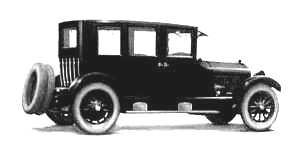
Models: According to Cadillac's "Closed Body Parts
Price List" effective December 1, 1921, the following body types were available: Type
59A (1) 4000 Victoria ($3,875), (2) 4010 Sedan ($4,100), (3)
4020 Suburban ($4,250), (4) 4030 Limousine ($4,550) - (photo in
Japanese catalog for 1987 cars, p.17), (5) 4040 Town Car, (6)
4050 Imperial Limousine ($4,600), Type 59B (7) 4130 Victoria, (8)
4140 Sedan, (9) 4120 Suburban, (10) 4150
Limousine, (11) 4170 Imperial Limousine, Type 59C (12)
4290 Victoria, (13) 4270 Sedan, (14) 4300 Suburban,
(15) 4360 Limousine, (16) 4350 Imperial
Limousine. Also available (and drawn from full-line catalog for Type 61) were these open
and closed bodies (17) 2-pass Roadster ($3,100), (18) 4-pass
Phaeton ($3,150), (19) 7-pass. Touring ($3,150), (20)
2-pass. Coupe ($3,875), (21) 5-pass. Coupe ($3,925),. All cars sit
on 132" wheel base (335.28cms). See CLCA 1974, p.27, CLCA 1976, p.23;
custom Sedan with California semi-Sedan top, CLCA 1977, p.27; opera Coupe, CLCA
1985, p.34, also Pride & Joy J. Shryackwas (photo), plus CLCA 1985, p.25 and in
color CC&CC 2/1985, p.11).
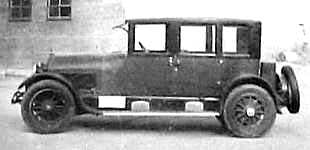
This one was for sale in Colorado in the
mid-seventies
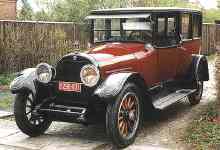 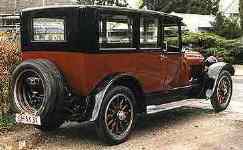
This splendid survivor belongs to Thomas Borchers, in
Germany
[ Photos, courtesy of the owner ]
Engine numbers: 61-A-1 to
61-Z-18006 [1921 + 1922-1923]
Trivia: The following
information was drawn from the magazine Automotive Industries which I was able to consult
at the Detroit Public Library in September 1994. Stupidly, I forgot to note down the
year/month of the magazine:
- Cadillac invests $2,000,000 in plant, p.833
1923

Cadillac body factory in 1923 (from a 1923
merchandising brochure)
Facts: Good article in AI, 22.9.21, pp.555-558. V8,
Type 61; 150,000 V8 cars had been produced by 1923; little change in appearance; minor
refinements; improved, thermostatically controlled carburetor for use with high or low
octane fuels; greater fuel economy; easier starting and quicker acceleration; thirty new
Cadillac-designed grinding machines installed at factory to manufacture transmission gears
to the finest limits; following information drawn from catalog on Cadillac enclosed cars:
dash equipment including: combined clock and speedometer with trip reset, combination
ammeter, oil and fuel gauge, cowl vent (controlled below dash), comb. lights &
ignition switch, dash lamp, auxiliary air pump, headlight tilt button, auxiliary air valve
button on dash, cigar lighter with ext. cord. Standard finish: black (three optional
colors), upholstery in finest mohair velour, top and headlining colors to harmonize with
seats and seat-back material, same material on robe rail, 132" wheel base (335.28cms)
all enclosed models, windshield wiper and rear view mirror standard, upper & lower
ventilating windshields.
Easy ID: Similar to 1922
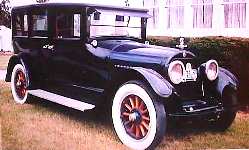
Models: (Enclosed cars): Type 61 (1) phaeton (photo
in CLC 8/93, p.8), (2) 7-passenger Suburban, (3) 5-passenger Sedan, (4) 4-passenger
Victoria , (5) 5-passenger Coupe, (6) 2-passenger Coupe, (7) 7-passenger
Limousine (photo), (8) 7-passenger Imperial Limousine (photo); (9) Landaulet
(photo); [more >>>>>]. For interior appointments, see 1923 catalog (p.2).
Engine numbers: 63-A-1 to 61-H-1550
[1923-1924]
1924-25
Facts: (new) 90° V-8 motor with
"compensated" crankshaft (crank throws are 90° apart and crankshaft is fitted
with compensating weights; also termed "Compensated" engine; engine photo SIA
5, p.24; new crankshaft "rotates with unprecedented smoothness"; the
fully counterweighted two-plane crankshaft meant that all primary and secondary forces
were balanced and engine smoothness was improved; bore and stroke 31/8x51/8"
(80x130mm), 314" (5 liter) displacement, 2 individual braking system, foot (service)
brake now on all 4 wheels, hand (auxiliary) brake on rear wheels only, 17" (43cm)
drums on all 4 wheels, tires 33x5", 132" (3m35) wheel base, 20-gallons fuel
tank( 75 liters), snubbers (??) front and rear; power up to 72HP; upholstery (Touring car)
extra-heavy pebble grain, dull finish black leather, (Phaeton & Roadster) long-grain
bright-finish black leather; (closed cars) selected mohair velvet or cloth fabrics,
cushion springs of Cadillac design, waterproof toolbox with lock, in RH dust shield; all
cars LH drive (French catalog mentions RH-drive available on request); fully-lined tops on
Touring car and Phaeton, sport top on Roadster, plate glass back-light in all tops, large,
transparent areas in side curtains fitted with double flaps on lower edge (tagged to
facilitate attaching), upper panels on all curtains may be opened for signaling and
ventilation, side curtains carried in special container bag with inserts to protect
lights, adjustable upper & lower windshield sections, closed cars also have sun and
rain visor covered with leather fabric; no dome lights in Coupe (equipped with ¼ lights,
dash-mounted 8-day clock (all models), 2nd 8-day clock in passenger compartment of open
Limousine, Brougham de Ville, Imperial Suburban and Imperial Sedan, speedometer visible
from rear compartment, comb. ammeter, air & oil pressure gauge, electric motor horn,
(automatic tire inflator mentioned in French catalog), foot rail in all models except
Coupes (and Roadster in French catalog), robe rail, license tag holders (not in French
catalog), rear view mirror, automatic windshield cleaner, electric cigar lighter on all
models except open Limousine and Town Brougham , portable insp. lamp on 14-ft. reel, under
hood, tire-holder for 2 tires with approved lock ("improved" instead of
"approved" in French catalog). Duco nitro-cellulose lacquer paint was introduced
(manufactured by Dupont de Nemours Company); it speeded up the painting process immensely
and improved the body finish.
Easy ID: Wider radiator; "drum" headlights;
radiator shell identifiable by the angular lines at the upper LH and RH corners: / \ (in
1925 these were changed to softer curves).
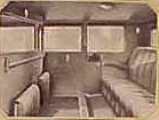
Limousine interior detail
Models: Initially eleven bodies with three more added mid
year; five custom-built closed cars in the third quarter of the year including (1) Landau
with oval ¼ windows accented by false landau bars [source: "Motor Age" and
"Motor World", 2.10.1924] (photo). Following prices are from Cadillac
advertisement of this period: (2) 7-passenger Touring car ($3085) (lots of photos,
including CLCA 1981, p.14-17, C&D card set); (3) 4-passenger
Phaeton ($3085) (photo); (4) Roadster ($3085) (photo). (5)
4-passenger Victoria-Coupe ($3275) (catalog photo). (6) 7-passenger Sedan ($3585)
furnished in Cadillac blue and upholstered in cloth of granite weave, and special taupe
color (photo: CLCA 1979, p.10). (7) Fisher 2-passenger Coupe ($3875). (8)
5-passenger Coupe ($3950) (photos in color and B&W); (9) 5-passenger Sedan de
Luxe ($4150). (10) Suburban de Luxe ($4250). (11) Imperial Sedan ($4400). (12)
Imperial Suburban ($4500) (photos in color and B&W); (13) Town Brougham
($4600) (photo). (14) Open-front Limousine ($4600) (photo). Five "Custom"
models introduced at years end on 138" wheel base (except Coupe -- on 132" wheel
base); photo/illustration: (SIA59, p.51); drawing of instrument panel (CLCA
1981, rear cover); custom cars: 3-position Landaulet + Convertible Sedan + Town car
by O. Heimburger, Basel [CH], (photocopy from HW, 11/92, in brochure "50
Jahre aus VSCI - USIC, 1919-1969", by Donald Brun); motor stage, CLC, 4/74, p.5.
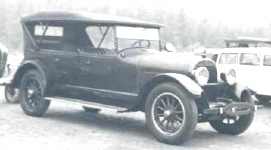
The touring car
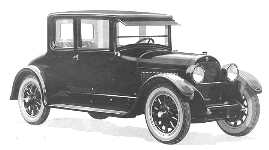 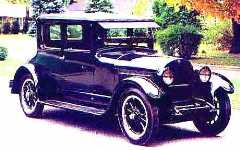
1924 Victoria [and survivor]
Engine numbers: 63-A-1 to 61-H-1550
[1923-1924]
Trivia: (1) King George of
Greece used a 1924 Cadillac [can be seen in period advertisement - artist: Neysa]. (2) The
Nairn brothers [Gerald and Norman]; chose Cadillac open touring cars for their
"Desert Mail" run between Beirut and Baghdad in 1923. Modified with small
refrigerators and asbestos-lined hoods, these Cadillacs could run all day and all night,
across 600 miles of burning desert terrain.
1925-26
>>>>>review 1925-1926 section (1926 models appeared July
1925)
1925
Facts: Lawrence P. Fisher took over as head of Cadillac in
April 1925 [source: AI, 23.4.1925]. Like 1924 models (V63). Trim materials used in
1925 including nickel, walnut and pewter. WHEEL BASE up to 138" (cms.) in 4 out of 5
new models. Prices from $3185 (open models) to $4950 for 7-passenger Imperial Suburban.
Factory building program almost completed with $2¼ million additional investment for 7
new foundries covering 7 acres. September : Fleetwood Body Corp was purchased for GM; ,
wood wheels with 33 x 6.75 low pressure tires, wire wheels optional at extra cost. Six
Duco color schemes are offered but any color scheme is available with 60 days notice.
Easy ID: Radiator shells, drum headlights and side lights
now nickel-plated; these models also also identifiable by the softer curves in the upper
LH and RH corners (in 1924 these were angular: / \) and the raised, upswept molding
carrying the Cadillac crest. Vertical shutters added in radiator shell, elliptical
crowned fenders, tool box on forward part of RH and LH running boards.
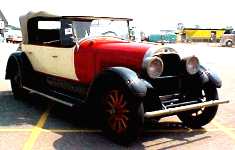 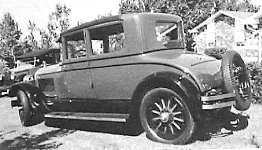
Two survivors: dual/cowl phaeton (left),
Victoria coupe (right)
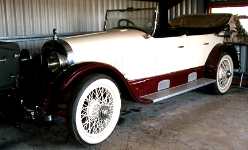  
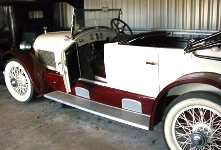 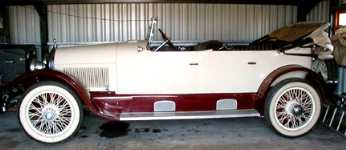
This lovely survivor is currently (2003) in the
United Kingdom
[ Photos: courtesy of the owner ]
Models: Series 314 and 314A; (1) a new Cadillac
"Mail coach" made its appearance early in the year [source: AI,
1.1.1925]; it sold for same price as open cars. Thirteen standard and custom Fisher
styles; these were, in the standard line on 132" wheel base: (2) 5-passenger
Brougham ($2995). (3) 2-passenger Coupe ($3045) (photos: side plus ¾ front view); (4)
4-passenger Victoria ($3095). (5) 5-passenger Sedan ($3195) (photo). (6)
7-passenger Sedan ($3295). (7) 7-passenger Imperial with division ($3435). The
Custom line on the 138" wheel base (except the Roadster on 132" wheel base, at
$3250) included: (8) 7-passenger Touring Car ($3250) (photos in color and B&W);
(9) Phaeton ($3250). (10) 5-passenger Coupe ($4000). (11) 5-passenger
Sedan ($4150) (photo). (12) 7-passenger Suburban ($4285) (photo). (13)
7-passenger Imperial ($4485) (photo). New article in AI for 30.7.25 (1926 models?)
mentioned Duco colors available were blue, Waverley gray and Arizona gray for the standard
line; the Custom models were available any color upon 60 days notice although 6 standard
colors were also offered. Nice Limousine photo: (MK 5/87, pp.52-53, plate
number VS819; HW collection) {***} custom bodies: Elkington [UK] did at least one
Cadillac body this year [source: MH article C/C 9/82, p. 27]; a special
Series 314 sport phaeton with body by Le Baron was shown at NY show [source: Hendry
article in C/C, 9/82, p. 27]; Brunn exhibited Sport Phaeton on "314"
chassis, with special radiator, hood and fenders at 1925 NY show (CC&CC,
9/1925, p.27); information.: 1924-25 Cadillac article Vintage Cadillac Returns to a
Vineyard (SIA112, pp.60-62)
Engine numbers: 63-H-1551 to
61-M-2572 [1925]
1926
Facts: This was the introduction year for the Series 314,
starting in July 1925, replacing the V63. The 200,000th Cadillac built was sold in January
1936 to Mr. Glenn H. Curtiss, famous inventor and manufacturer of airplanes and
hydroplanes [source: MA, 7.1.1926]. Opening of new administration building
finalized (vast construction program had begun in 1919). A caption to an illustration in
the 1926 product catalog says Public preference for the Cadillac is pronounced only
because public confidence in Cadillac mechanism, coachwork, and policies has never been
betrayed. Year after year, this car has maintained its position, well in the van of
engineering thought and practice; year after year, it has accorded its owners an excess
measure of travel comfort, Its leadership has become traditional. Its worth is
acknowledged, and everywhere the public mind is firmly settled in the conviction that
ultimate degrees of motoring satisfaction may be attained only with the Cadillac.
Extensively re-engineered car for 1926. engineered by Ernest Seaholm[ chief engineer],
C.W. Strickland [assistant chief engineer], Frank Johnson engineer and transmission
design], H.H. Gilbert [research engineer], G.E. Parker [designer] and W.N. Davis [body
engineer] these models constitute link between Leland era and Seaholm/Earl era where
styling became pre-eminent; third "generation" V8 since 1914-15 model; in late
1925, Cadillac asserted that of 180,000 cars built since 1902, not a single engine was
ever replaced by the factory for any reason; same bore and stroke, crankshaft and
structure as earlier engines, major differences in cooling and electrics; only one pump
used, thermostatic radiator shutters replaced valve type, Delco 2-unit electrical system;
vertical starter motor and separate generator replaced single unit crankcase ventilation,
; new longitudinal, semi-elliptic rear springs in lieu of former platform, giving lower
profile; new rounded radiator shell. Weight down 250 lbs (130lbs off engine alone, down to
714 lbs). Power up from 80HP to 87HP. Prices also reduced, starting at $2995;
vertical-mounted starter-motor, single water pump instead of two used formerly,
thermostatic control of engine temperature through automatic, vertical radiator shutters,
new, nickel radiator shell, improved crankcase ventilation, new 60" long
semi-elliptic rear spring for improved ride, new "Silico-chrome" valves, 4-pole
Cad-Delco generator belt-driven from camshaft, Exide 130 a/h 6V battery, tilt-beam
headlamps, 15 carbon-steel clutch plates (down from 17), gear ratios: 4.91 to 1, 4.5 to 1
and 4.15 to 1. Tires: 33x6.75" cord balloon. Wheel bases: 132" [Standard line],
138" [Custom line] and 150" [chassis only], tread 56", fuel capacity: 16.67
imperial gallons (75.7 liters); bodies: with interior, patent-construction armrests, inner
doors garnished with walnut window moldings, sturdy doors with outside door handles and
double safety catches; combined interior door and pull-to handle, instrument board with
walnut inset panels, battery located in locked metal case inset in LH front fender, tools
in locked case on RH front fender. All open cars upholstered in soft finished hand-buffed
leather, closed cars in selected Mohair velvet or cloth fabrics, cushions and back springs
of special design encased in fabric, standard jobs have cotton bats in plain pleats, rigid
metal running boards with ribbed rubber matting and white metal binding with black facing;
large cowl ventilator, motor-driven horn on LH headlamp bracket (control button in center
of steering wheel), universal key for switch, tool-box, tire carrier, gearshift lever and
door locks on all enclosed models; starting January 1936: special Fisher, flat, swing-out
"V-V" windshield on closed cars, slanting, one-piece windshield with vent wings
on open cars, combined cigar lighter and inspection lamp on 12-ft. cord, 8-day clock on
all dashes, foot rail in all models except coupes], electric motor horn, power
air-compressor for tires, robe rail, license tag holders, rear view mirror, automatic
windshield cleaner, tire carrier with approved lock, vanity [toilet] cases [closed cars
only], trunk rack [Brougham, Phaeton and 5-passenger Sedan only]; [source: AI,
30.7.25 and Hendry articles in C/C, 9/82, p. 27 and SCC, pp.
>>>>>].
Easy ID: Battery box and tool-box mounted on forward part
of running board, integral with front fenders. Fourteen hood louvers.

Models: Later in the year, custom Fleetwood bodies became
available on individual order. According to 1926 product catalog, all bodies were
Fisher-built.. The standard line embodied Cadillac's highest ideals of travel comfort
and of beauty. Furnished in Duco [Dupont Company] finish in various color
treatments, they are cars of distinctive charm. The standard line [in order of
appearance in the catalog] had flat, vertical windshields, smallish drum headlamps, plain
nickel door handles; included were: (1) 2-passenger Coupe, (2) 5-passenger
Sedan, (3) 7-passenger Sedan, (4) 4-passenger Victoria, (5) 5-passenger
Brougham. The Custom line mainly on 138" wheel base, identified immediately by
sloping, one-panel, swing-out windshield [except Touring Roadster and Phaeton which had
special slanting windshields], a special flush roof bead molding [rain gutter], motometer
on top of radiator grille, outside door handles in hard rubber finish, double bar front
bumpers and twin rear "bumperettes"; they had dome lights and ¼ panel lights
[dome lights came on automatically when door was opened]; door sills were covered in
white, rust-proof metal, inside hardware had enamel inlay harmonizing with body
upholstery, richly inlaid hardwood panels on doors and smoker cases, detachable toilet
[vanity] and smoker cases, solid hinged robe rail with end handles, silk cord assist
handles at top of rear door posts, cable-type window lifters, upholstery laid over
special, fabric-encased springs, front and rear bumpers, motometer, molded rubber running
board mats, running-board step plates, oversized drum headlamps; an electric gasoline
gauge was standard as were combined parking and headlights in oversized, nickel-plated
drum-type headlights, 33x6.75" tires on a choice of wood, steel disc or wire wheels,
and the new "VV" swing-out, ventilating windshield. Custom line: (6)
5-passenger Sedan, (7) 7-passenger Touring with 5-bow top, covered in heavy black
leathered fabric with full headlining, and side curtains that opened with doors, (8)
5-passenger Coupe, (9) 2-passenger Roadster [on 132" chassis] with 3-bow top, (10)
4-passenger Phaeton with 4-bow top, (11) 7-passenger Suburban [not illustrated in
catalog], (12) 7-passenger Imperial Suburban. Seven standard Duco color treatments;
any color available on request but waiting time needed. Five more Fisher bodies were
available: (13) 5-passenger Sport Landaulet Sedan. (14) 2-passenger
convertible Coupe [both on 132" wheel base]. (15) 7-passenger Imperial Sedan
[on 138" wheel base]. (16) Sport Phaeton. (17) 5-passenger Victoria
Coupe]. Other custom bodies available from Brunn, Fleetwood, Judkins and Le Baron [there
were 4 by Brunn and 10 by Judkins and Le Baron (source: Hendry article in C/C,
9/82, p.27)]; one custom body by Brunn [a Convertible Coupe], executed much in the
Lincoln tradition, was exhibited at the 1926 NY show (CC&CC, 9/1925, p.27)
photos: 2-passenger Coupe (CLCA 1977, p.38 and CLCA 1981, p.26); small photo
of instrument panel (CLCA 1982, p.28); sedan (CLCA 1979, p.31);. Good
article in AI, 2.12.25, pp.278-279 Unsprung Weight in Cadillac Reduced; Town
Car photo in CLC for 4/79 (rear cover); MA. July 29, 1926; SS,
3/65
Engine numbers: 100001 to 150619
[1925-1926]
Trivia: the 1926 Cadillac had
sixty-five lubrication points
1927
Facts: Series 314 and 314-A eight-cylinder,
The Series 314, built 7/25 - 7/1926 was replaced by an updated Series 314A, built 71926 -
8/1927. Large drum headlights on all models instead of only on "Custom" models,
new walnut instrument panel with silver inlays. First appearance of term
"Cabriolet" to designate closed body style with leather-covered roof portion.
Many dealers staged "Silver Anniversary Salon" in Oct. 1926 to officially launch
1927 models. Chicago dealer exhibited 30 models in huge tent, transformed into a garden,
where full orchestra entertained nightly; show drew 2000 visitors a day. La Salle models
made their appearance [see La Salle database]. "Refinements" are described in AD,
1/27, pp.32+99: push-pull type ignition switch, new light control switch on steering
wheel, forward-folding windshield on roadsters and phaetons, adjustable seat in roadster,
distinctive interior features, new nickel side lamps, new Delco ignition.
Easy ID: Battery box and tool-box removed from running
board and stored in sill compartments. Still fourteen hood louvers. New, colored Cadillac
emblem on black background in center, top of radiator. Last of the drum-shaped parking
lights and headlights.

 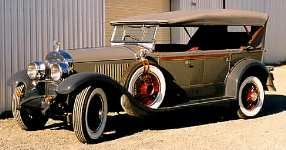
Above: artist's view and actual phaeton
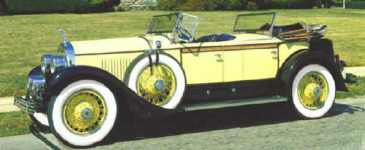
The sporty dual-cowl phaeton
Models: Introduced already in summer of 1926; 50 styles
were offered in 500 color combinations. Eighteen Fisher bodies of which five were new
styles. Eleven styles were new or modified. Four new, so-called "cabriolet"
styles were the Custom 5-passenger coupe, 5-passenger sedan, 7-passenger suburban and
7-passenger imperial. Among the modified bodies were the Standard 7-passenger sedan and
7-passenger imperial both put on the 138" chassis, and the Victoria which was
increased from 4 to 5 passengers. Entirely new styles included the 2-passenger sport
coupe, the 5-passenger sport sedan, the 2-passenger convertible coupe and the dual-cowl
sport phaeton. Special custom offerings were available from Brunn, Fleetwood and
Willoughby; different radiator and fender design with inside compartments for battery and
tools, instead of being located in boxes on fenders. Special hearse and ambulance bodies
available on a new 150" chassis, built for Cadillac by Meter of Piqua, Ohio. Styles
much like 1926. Standard line: (1) 5-passenger Brougham ($2995). (2)
2-passenger Coupe ($3100). (3) [new] 2-passenger Sport Coupe ($3500). (4)
5-passenger Victoria [formerly 3-pass.] ($3195). (5) 5-passenger Sedan ($3250). (6)
[new] 5-passenger Sport Sedan ($3650). (7) 7-passenger Sedan ($3400). (8)
7-passenger Imperial [limousine with divider] ($3535), now 138" wheel base
(350,5cms.). (B) Custom styles: (9) 2-passenger Roadster ($3350) (photo, CLCA
1979 p.11). (10) 4-passenger Phaeton ($3450). (11) [new] Sport Phaeton,
double cowl ($3975). (12) 7-passenger Touring Car ($3450). (13) [new]
2-passenger Convertible Coupe ($3450) (photo in CLCA 1979, p.11]. (14)
5-passenger Coupe ($38575). (15) 5-passenger Sedan ($3995). (16) 7-passenger
Suburban ($4125). (17) 7-passenger Imperial ($4350). (18) 5-passenger Coupe
Cabriolet with leather top ($3955). (19) 5-passenger Sedan Cabriolet with leather
top ($4095). (20) 7-passenger Suburban Cabriolet ($4225). (21) 7-passenger
Imperial Cabriolet with leather top ($4450). "Custom" styles are on 138"
wheel base except the roadster (on 132" wheel base). Additional styles (and
apparently first use of Fleetwood styling codes): (22) 2891 Limousine Brougham
($5525). (23) 2925 Town Cabriolet with auxiliary seats ($5750). (24) 3012
Transformable Town Cabriolet ($6500). (25) 3200 Town Cabriolet with opera seats
($5500). (26) 3202 2-passenger Coupe with rumble seat ($4775). (27) 3260
5-passenger Imperial ($4975). (28) 3260S 5-passenger sedan ($4875). (29)
3261 5-passenger Imperial Cabriolet ($5125). (30) 3261S 5-passenger Sedan Cabriolet
($4975). (31) 3275 7-passenger Imperial ($5150). (32) 3275S 7-passenger
Sedan ($4975). (33) 3276 7-passenger Imperial Cabriolet ($5375). (34) 3291
Limousine Brougham ($5525). Other custom bodies: 4 custom bodies by Brunn were proposed,
as were 10 others by various coach-builders [source: Hendry article in CC&CC,
9/82, p.27]. Series 303 La Salle convertible coupe (C&D card set).
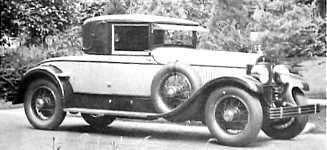 
Left: 1927 Silver Anniversary Salon model (October,
1926); right, this surviving 5-pass Victolria needs a lot of TLC
Engine numbers: 300001 to 320001
[1927-1928]
1928
Facts: Series "341" [indicating 341 cubic inches
engine displacement - formerly 314 cu" ]; information: (CLCA 30th anniversary
issue, p.38); mechanical features: Compensated 90° V-8 engine, bore and stroke
35/16x415/16, 341 cubic inches displacement , 35.1 HP (SAE rating), 90HP actual, new
design clutch (2 driven discs 9½" diameter both sides faced with compressed asbestos
fabric, driven by flywheel), 21-gallons fuel supply, 6-gallons water cooling, 21¼"
6-blade fan, HF vibrator-type horn, 2 tilt-beam headlamps, 2 side lamps, 2 rear lights (RH
stop light, LH tail light), step lights in dust shield light automatically on opening
doors , front brakes equalized when straight ahead, 16" drums on all wheels (down
from 17½"), 19" diameter steering wheel (up by 1"), new rubber composition
instead of walnut, instrument board with windshield wiper control, carburetor heat
control, spark control, oil pressure gauge, carburetor enriching device, instrument light
switch, speedometer, ammeter, electric fuel gauge, 8-day clock, ignition lock, engine
temperature indicator, combined inspection lamp & cigar lighter; one-piece, full-crown
wide fenders, gear ratio 4.75 to 1, tires 32x6.75 cord balloon, 140" wheel base
[formerly 132" and 138"], 9" ground clearance, artillery type hickory
wheels with steel felloes. 18004 units built. Catalog printer was still Evans-Winter-Hebb
Inc., Detroit. Article by A.F. Denham in AI, 10.9.27, pp.366-369, "New
Cadillac Announced has Larger Engine, Longer Wheel base" (has cross-sections of
"341" engine on pp. 368 and 369).
Easy ID: Lights now cone-shaped. Parking lights still at
firewall level. Numerous, narrow hood louvers not extending all the way to the radiator
shell.
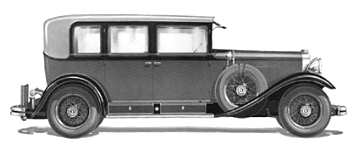
Models:(body styles): Longer, more
streamlined car this year; 26 basic body styles offered [ads. mentioned 50 in all]. At the
24th NY Automobile Salon that opened on 2 December, 1927, Fisher exhibited five bodies on
the LaSalle and three on the Cadillac chassis; Fleetwood exhibited two La Salles [a town
car and an all-weather phaeton], plus an art moderne Cadillac town car; the latter
featured a polished aluminum, damascened, recessed hood and cowl; all the moldings around
the windows, top and back were in polished aluminum; lamps, windshield frame and wheel
spokes were chromium-plated; a silver leaf stripe on the car's black finish matched the
effect of the polished aluminum; a new rayon fabric piped with silver leather was used on
the seats and armrests; the ceiling, inner rear quarter panels and rear panel were lined
with a plain rayon material; opera seats were fitted against the division of which the
cabinet had elaborate inlays of 22 different polished hardwoods in a modernistic design;
interior hardware was color plated in a 2-tone effect1;
other Cadillacs by Fleetwood on exhibit at the salon included a convertible coupe, an
all-weather phaeton with division glass, a 5-passenger sedan with small rear quarter
windows, a town brougham with rear quarter windows and metal back, a 5-passenger
"club cabriolet", a town car, a 7-passenger town car and a 7-passenger
limousine. Also on show was a 3-position town car/landaulet/open touring car with a body
by Hibbard and Darrin of Paris. Fisher "custom" models for 1928 include: (1)
2-passenger Roadster with rumble seat ($3350), 4439lbs. (2) 7-passenger Touring Car
($3450), 4668lbs. (3) 4-passenger Phaeton ($3450) [CLCA 1989, p.9)]. (4)
4-passenger D/C Sport Phaeton ($3950), 4770lbs [story and photos in CLCA 30th
anniversary issue, pp.11-13, C/C 2/1977, pp.22-23, photo C&D card set]. (5)
2-passenger Coupe with rumble seat ($3295), 4597lbs. (6) 2-passenger convertible
Coupe with rumble seat ($3495), 4597lbs [photo: CLCA 1979, p.12]. (7)
5-passenger Coupe ($3495), 4700 lbs. (8) 5-passenger Town Sedan ($3395), 4843lbs. (9)
5-passenger Sedan ($3595), 4846lbs. (10) 7-passenger Sedan ($3695), 4934lbs. (11)
5-passenger Imperial Sedan ($3745), 4841lbs. (12) 5-passenger Imperial
cabriolet ($3745). (13) 7-passenger Imperial Sedan ($3895), 5067lbs. (14)
7-passenger Imperial cabriolet ($3895). Bare chassis 140" ($2800). Fleetwood
bodies: (15) style 8025 5-passenger sedan ($4095), 4950lbs. (16) style
8045 5-passenger Sedan cabriolet ($4095), 4950lbs [later V16 styles with final digits
"55S" were similar in appearance]. (17) style 8055 5-passenger Imperial
sedan ($4245), 4960lbs [later V16 styles with final digits "55" were similar in
appearance]. (18) style >>>>> (???) 5-passenger Imperial cabriolet
($4245), 4960lbs. (19) style >>>>> 7-passenger Sedan ($4195),
5050lbs. (20) style >>>>> (???) 7-passenger Sedan cabriolet ($4195),
5050lbs. (21) style >>>>> (???) 7-passenger Imperial sedan ($4445),
5180lbs. (22) style >>>>> (???) 7-passenger Imperial cabriolet
($4445), 5180lbs. (23) style 3512 7-passenger Town Car ($5000). (24) style
3520 7-passenger Town Car ($5500). (25) style 3525 7-passenger Town Car ($5500). (26)
style 3591[>>>>> (???)] 7-passenger Town Car ($5500). Other custom
bodies: [extracted from French Cadillac-LaSalle portfolio catalogue with 14 B&W
plates] Hibbard & Darrin town car (CLCA 1976, p.17); H&D Convertible Sedan
(CLCA 1989, p.8); Kellner, Town car (proposal only? CLCA 1989, p.10);
Million-Guiet, Town car (proposal only? CLCA 1989, p.11).
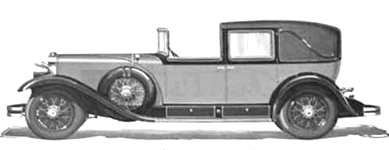
Fleetwood style #3525 town car (from that year's
small product catalog);
they called it a Transformable Town Cabriolet
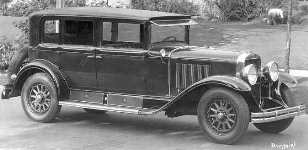
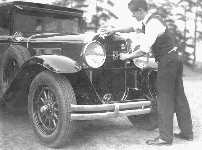 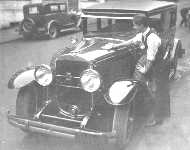
These two rows: 1928 sedan for 5 passengers
 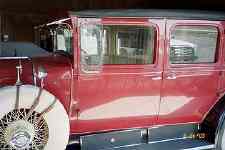 
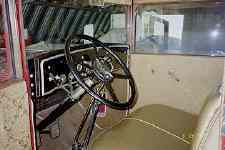 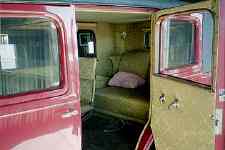
Here's a nice surviving, leather-back limousine
Engine numbers: 320002 to 338104
[1928-1929]
1929
Facts: now designated Series 341-B indicating no change in
engine displacement; 18004 units 341B built; engine rated 95HP, optional low compression
engine 4.8-1, new Syncro-Mesh transmission for noiseless, smooth gear changing at all
speeds [did away with "double clutching"], "coincidental" (i.e.
"combined"] theft-proof lock for ignition and transmission (on dash), starting
motor mounted on RH side of transmission, parking lamps mounted on top of front fenders,
new Duplex-Mechanical brakes, entirely enclosed, steering reduction 15 to 1, tires
7.00x20" cord balloon (formerly designated 32x6.75"), 140" wheel base, RH
turning radius 23', LH 25' 1", gear ratio 5.03 to 1 (optionally 4.75 to 1), new
Security-Plate Glass fitted in all models. Double-acting Delco shock absorbers were
introduced (CLC 7/93, p.4). First mention of GMAC deferred payment plan. Standard
equipment: one spare rim, shock absorbers, front and rear bumpers, rear view mirror, sun
visor, cowl ventilator; closed cars have in addition: ventilating windshield, smoking
case, vanity case, corner lamps and dome lamp, adjustable front seats, Security-Plate
glass in all doors , windows and windshields, chromium plating on all external nickel
parts. Wire or disc wheels optional at extra cost. Another $5 million were earmarked for
plant expansion, to increase output by 50%. Unexpected stock-market crash of October 1929
adversely affected 1930 production. Good write-up in AI, 25.829,
pp.256-259
Easy ID: Like 1928, except parking lights moved to top of
front fenders.

Petiod pic, from a French auto magazine [ZTV coll.]
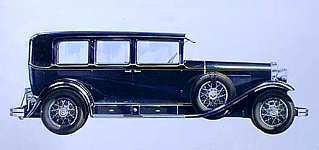 
Limousine for 7 passengers (left), surviving
convertible coupe (right)
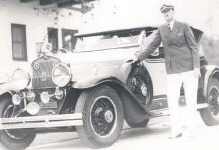
A d/c phaeton from "way-back-when"
Models: 1929 was the year of "daring art
conceptions"; in an advertising fantasy for 1929 (?) Cadillac's in-house magazine
"The Crest" likened some of the year's creations to the following works of the
world's art: "The Magnificent" (by Boticelli), "The Noble Slav" (by
Rembrandt), "Philip IV of Spain" (by Velásquez), "The Laughing
Cavalier" (by Frans Hals), "The Conversation" (by Watteau) [inspired the La
Salle 5-passenger Sedan], "Col. George Coussmaker" (by Sir Joshua Reynolds),
"Souvenir of Normandy" (by Corot), "Head of a Young Girl" (by
Vermeer), "Flora" (by the Titian), "King Henry VIII" (by Holbein),
"Blue Boy" (by Gainsborough), "Carnation Lily, Lily Rose" (by
Sargent), "Mona Lisa"" (by Leonardo Da Vinci), "Swimmers" (by
Sorolla), the ceiling of the Sistine Chapel by Michaelangelo, "Le Chapeau de
Poil" (by Rubens) and "Cremone Lights" by Whistler). As quoted by the
writer, Frenchman Albert Desjardins, these paintings were chosen by Fisher and Fleetwood
as a basis for "a novel conception in equipage design". "Series 341-B:
Fleetwood body styles, ranging in price from $4195 to $7000, most Cadillac prices up (from
$100 to $250) since last year. Cadillac "Custom" models by Fisher on
140" wheel base: (1) 2-passenger Roadster ($3350), 4781lbs (small photo, CLCA
1987, p.24). (2) 7-passenger Touring ($3450), 4774lbs. (3) 4/5-passenger
Phaeton ($3450), 4606lbs. (4) 4-passenger Sport Phaeton ($3950), 4906lbs. (5)
2-passenger Coupe with rumble seat ($3295), 4909 lbs. [Following are all up by $100 since
1928] (6) 2-passenger Convertible Coupe with rumble seat ($3595), 4796lbs. (7)
5-passenger Coupe ($3595), 4887lbs. (8) 5-passenger Sedan ($3695),
5040lbs. (9) 5-passenger Town Sedan ($3495), 5030lbs. (10) 7-passenger Sedan
($3795), 5140lbs. (11) 7-passenger Imperial ($3995), 5156lbs. Cadillac by
Fleetwood on 140" wheel base: [all up $100 since 1928] (12) style 3830S
[or 3930S?] 5-passenger sedan, metal back and rear quarter panels ($4195), 5200lbs. (13)
style 3830 5-passenger imperial [as above] with division glass, robe cord instead of rail
($4345), 5300lbs [also (14) style 3830C 5-passenger imperial landaulet] and (15)
style 3830SC 5-passenger Landaulet Sedan]. (16) style 3855S 5-passenger Sedan
cabriolet, as above but no glass division or phone, has adjustable front seat, rail
instead of cord ($4195), 5170lbs [also (17) style 3855SC 5-passenger Landaulet
Sedan] ($5250), 5230lbs. (18) style 3875S 7-passenger Sedan, no divider ($4295),
5300lbs. (19) style 3855 5-passenger Imperial Cabriolet, full leather back and rear
¼-panels ($4345), 5320lbs. (20) New style 3861S (?) 5-passenger Club Cabriolet or
Close-coupled Sedan with full leather back and rear ¼-panels, trunk ($4395), 5200lbs
[also (21) style 3861SC 5-passenger close-coupled Landaulet Sedan]. (22)
style 3975S (3875S?) 7-passenger Sedan ($ .......). (23) style 3875 (3975?)
7-passenger Imperial, metal back and rear ¼-panels, 2 forward facing extra seats,
upholstered over springs ($4545), 5340lbs [also (24) style 3875SC 7-passenger
Landaulet Sedan ($5500), 5320lbs]. (25) New style 3180 5-passenger all-weather
phaeton model with Burbank top, back and rear quarters, inside bow, fully collapsible,
without glass partition, weight 4880[5140?] lbs, cost $5750 [source: McC, p.131]. (26)
same style 3880 Imperial Phaeton Sedan with glass partition ($5995), 5280lbs [have Dumka
drawing of similar (27) style 3550?]. (28) style 3512(?) Town car, full
leather back and quarter panels, 2 opera seats ($5250, up from $5000), [also (29)
style 3512C Town Landaulet]. (30) style 3520 (?) Town Car, as above with quarter
windows, 2 extra forward-facing seats upholstered over springs ($5500), [also (31)
style 3520C Town Landaulet]. (32) style 3525 Town car, full, leather back and
quarter panels, 2 forward facing extra seats, upholstered over springs ($5500). (33)
style 3925 [1930 ???], also (34) style 3525C Town Landaulet style. (35)
unique style 3885 custom 4-passenger Victoria Convertible Coupe (only 1 assumed built,
body N° 11616) (SS [???] - photos: RH front side, RH rear side, body tag,
rear, top down, interior top, headlight emblem, Pennsylvania "V" windshield,
trunk and rear wheel). (36) style 3591 Town Car, metal back, full ¼-windows, 2
forward facing extra seats, upholstered over springs ($5500), 5280lbs [also (37)
style 3591C Town Landaulet and 3991 - 1930 ???]. Special Cadillac by Fleetwood on
152" wheel base: (38) 5-passenger Sedan with leather-covered roof and mail
coach sill, built for prominent motor-car official2.
Following additional 1929 prices not mentioned above are from 1929 product
sheet for (39) 7-passenger Imperial. Bare chassis, 140" wheel base ($2800). (40)
5-passenger Imperial Sedan ($3895). 1929 Photos: Town Sedan (photo, CLCA 1977,
p.38); Town Car [same issue] (also CLCA 1977, p.42); D/C Phaeton (CLCA 1974,
p.31). It was a custom 1929 LaSalle model designed by Harley Earl that inspired the
"Madame X" appellation on a limited series of V-16 closed body styles in 1930.
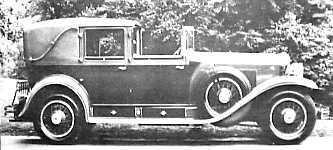 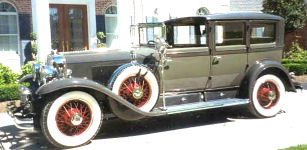
Left: factory photo of Fleetwood style #3125, town
car for 7 passengers
Right: a lovely, surviving Fleetwood style #3591, town car for 7 passengers
Engine numbers: 500001 to 511005
[1929-1930]
1930
Facts: Good write-up in AI, 14.9.29, pp.368-370
[see also V12 and V16 sections]. Adverse effects of October 1929 stock-market crash. Some
custom V-8 models had "Madame X" overtones [see McC p.133]. V8
specifications [1930 Series "353"]: indicating increase in engine displacement
to 353 cu.", bore up by 1/16" to 33/8". compensated, 8-cylinder , V-type,
90° between cylinder blocks, 5-point suspension, rubber supports front and rear, 353 cu.
in., bore and stroke 33/8x415/16", NACC power rating 36.45, actual more than 95HP,
spark plug and header covers for trim appearance, 21" (cms.) 6-blade fan, 120 a/h
battery [under RH front seat], 2 electric vibrating horns, combined stop and tail-light on
LH rear fender, all brakes 15" diameter (cms.), 17 to 1 steering reduction, gear
ratios 4.75 to 1 [optional 4.07 to 1 and 4.54 to 1], 134" wheel base (cms.), rear
tread 59½" (cms.), front 57¼" (cms.), tires 6.50x19" [7.00x18"
optional wheels and tires], tools in special fabric holder under front seat, special
dash-insulating material against heat and engine noise. Brakes now enclosed for greater
protection. New double stop/tail lights. Closed cars pre-wired for Delco-Remy radio [extra
$150]; antenna concealed in top. Facts drawn from The Picture Book of Fleetwood]:
The owner of a new [1930] Cadillac can travel smoothly and quietly at the speed
he chooses - with positive certainty of control in steering and stopping, with multiple
factors of safety, with complete freedom from rasping gears, with restful absence of those
annoying rumbles which all too frequently mar the enjoyment of closed car transportation.
In short, he travels in complete and wholly satisfying luxury. Power output unchanged
(95HP) despite changes in combustion chamber and valve design; fully harmonized steering
system, silent-shift Syncro-Mesh transmission , fuel supply up to 25-gall., cooling to
6¼-gall., dry disc plate clutch with two 10" diameter steel discs, 16½"
diameter brake drums, spring suspension with double acting hydraulic shock absorbers, gear
ratios 5.08 to 1 (standard), optionally 4.75 to 1 or 4.39 to 1, turning radius RH
24'7½", LH 25', tires 7.00x19, roomier bodies [rear seats 4" wider than
previous models], 7-passenger Sedan and Imperial are 3" longer in rear compartment,
new folding armrest (rear seat, center), interiors of sumptuous fabrics - mohair,
broadcloth or whipcord, bright silver metal ware, metal vanity cases and smoking sets
inset with matching upholstery trimming, improved acoustics through use of anti-friction
tape between wood-wood, wood-metal and metal-metal contacts, rigid top framework (ash),
padded to prevent rumbling, inner body sprayed with emulsified asphalt to dampen
vibrations and insulate body, rubber shims between frame and body. To ride in the 1930
Cadillac was a revelation in what contemporary motoring has to offer as an experience
in wholly satisfying luxury; new steering modulator on front of LH spring, new
19" diameter die-cast aluminum, steel-cored steering wheel, finished in black
pyrolin. New nation-wide service policy for Cadillac owners. Over-all length of body:
211" (536cms.) Hendry article on V16 in SCC, pp.49-50. Article on Madame X
by R. Burns Carson in SCC, pp.51-52; ATJ, 10/1929; ATJ,
9/1930 [new V12 models]
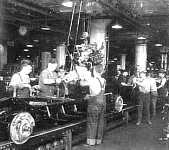
The assembly line in 1930
Easy ID: Like 1929, except hood louvers now extend all the
way to the radiator shell. "V8" badge on stanchion between headlights and on
wheel covers.

Fisher town car style
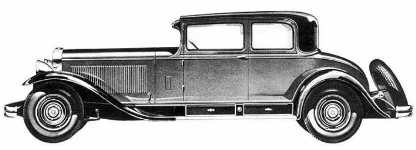
Fisher-bodied coupe for 5 passengers
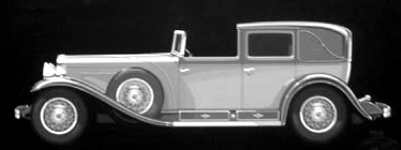
Fleetwood style #3955, the Fleetmere
sedan/limousine for 5 passengers
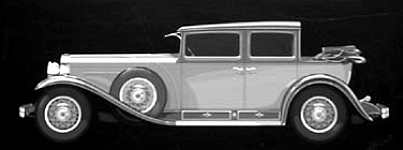
Fleetwood style #3955C, like the Fleetmere,
above, but the landaulet version

Fleetwood style #3912, the Fleetwick town
car for 5/7 passengers
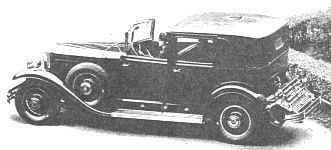 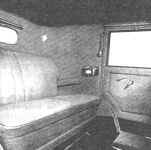 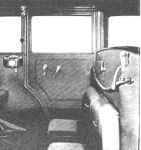
Fleetwood style #3925, the Fleetcrest town
car for 5/7 passengers
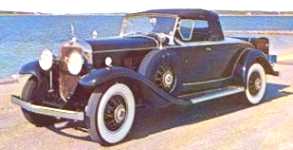
This is the smart and sporty roadster with V-8 motor
(it was availablealso in V-12 and V-16 configuration)
V12 ID: Single, central running board light with long,
chrome molding on either side of it. In addition, "V12" badge on stanchion
between headlights and on wheel covers.
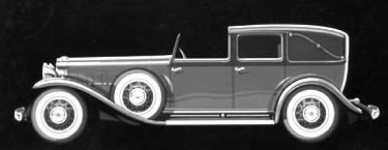
This is Fleetwood stye #4825, a town car for 7
passengers
V16 ID: "V16" badge on stanchion between
headlights and on wheel covers. Three basic styles: (1) - the most common - curved, raised
hood molding running from rear edge of radiator housing, curving across hood and down to
sill level just ahead of front doors; split "V" windshield, running board light
between two sets of decorative horizontal chrome moldings on sill storage compartment
doors (above, below and on either side of compartment door lock); (2) - quite common -
horizontal belt molding, curved sill (or "coach" sill), single running board
light; storage trays at forward end of sill; (3) - least common - Madame X
styles, with horizontal belt molding, horizontal sill like first style, above, also with
two running board lights and decorative horizontal chrome moldings on storage compartment
doors; style (3) is further divided into flat and "V" windshield styles: (3a)
these models feature an almost vertical, split "V"-windshield and a special
instrument panel in two parts, shared between driver and front seat passenger; they cars
were built (together with the "V"-windshield town cars) at the old Fleetwood
works in Fleetwood, PA; (3b) these are the more common of the two (although still
relatively rare); they feature a flat, 18° slanting windshield, slender "A"
pillars and chrome or light-colored window frames. In addition, some standard Fisher
bodies were also mounted on a number of V16 chassis; my guess is that you could only tell
them apart from the V8 models by the "V16" radiator grille badge. Has anyone out
there ever actually seen a 1930 V16 with a standard Fisher body? It is rumored that a
style "168" Fisher Convertible Coupe might still be around]. The Fisher V16s are
recognizable for being built on the 143" (363.22ms) wheel base chassis; the Fleetwood
bodies used the 148" (375.92 cms) chassis. Author Richard Burns Carson mentions three
different instrument panels on the V16. I know of only two: (i) the split panel of the Madame
X cars built in Pennsylvania and (ii) the oval panel of the other sixteens, which was
like the standard V8 and V12 panel. What was the third, if any ???

Fleetwood Madame X style (1): here
#4155/4155S formal limousine/sedan for 5 passengers
[ verical windshield, straight belt molding, fine windshield posts, chrome
window surrounds ]
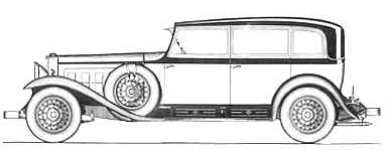
Fleetwood Madame X style (2): here
#4130/4130S limousine/sedan for 5 passengers
[ as above, but with 18º, raked windshield ]
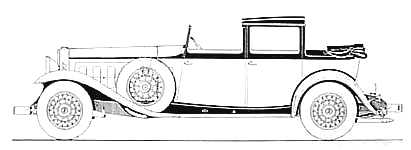
Fleetwood style #4212C, landaulet for 5 passengers
[ curved, so-calld "coach" sill ]
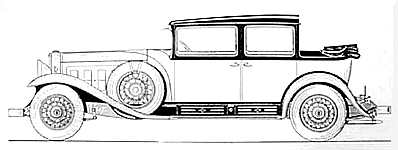
Fleetwood style #4355C, landaulet for 5 passengers
[ raised hood molding curving around spare wheel mount ]
Models: Some 1930 V-8 models had later "Madame
X" overtones [see McC p.133]. New sloping windshield helped reduce glare.
Total number of styles down to 34 [including La Salle models]. Twenty-one body types in
all, comprising over 100 "different" body styles: seven Fisher Custom bodies
were: (1) 2-passenger Coupe. (2) 2-passenger Convertible Coupe [story TQ,
11-12/84, pp.4-5]. (3) 5-passenger Coupe. (4) 5passenger Sedan. (5)
5-passenger Town Sedan. (6) 7-passenger Sedan. see TQ7-8/85, p.14; (7)
7-passenger Imperial Sedan. There were at least fourteen Fleetwood Special Custom designs
[excerpted from "Book of Fleetwood"] and a number of sometimes unique styling
variations on individual themes: according to "The Picture Book of the
Cadillac", some of the following are Fisher Custom and Fleetwood Special Custom
bodies that were available: (8) 2901LX special Fisher 7-passenger Sedan on V16
chassis,. (9) LX2905 special Fisher 5-passenger town sedan on V16 chassis, (10)
LX2913 special Fisher 5-passenger Coupe on V16 chassis, (11) 2950X special
Fleetwood 7-passenger Sedan on V16 chassis, (12) 2951LX special Fisher 7-passenger
Sedan on V16 chassis, (13) 30X special Fisher 7-passenger Sedan [test car for V16
motor], (14) 3289B special Fleetwood 7-passenger Town Car, (15) 3520 Town
Car, with ¼-windows, 2 extra forward-facing seats upholstered over springs. (16)
3520C Town Landaulet, as above but with folding roof over rear seating area. (17)
3525 Town car, full leather back and ¼-panels, 2 forward facing extra seats, upholstered
over springs [like 3925???]. (18) 3525C Town Landaulet, as above but with folding
roof over rear seating area. (19) 3591 Town Car, metal back, full ¼-windows, 2
forward facing extra seats, upholstered over springs [like 3991???]. (20) 3591C
Town Landaulet [like 3991C???], as above but with folding roof over rear seating area. (21)
3902 Fleetdowns 2-passenger Roadster (C&D card set?). (22) 3912
Fleetwick Town Cabriolet with opera seats [town car]. (23) 3912C Fleetwick Town
Landaulet, as above but with folding roof over rear seating area. (24) 3920
Fleetmont Town Cabriolet [town car], with ¼-windows and 2 auxiliary forward-facing seats
upholstered over springs. (25) 3920C Fleetmont Town Landaulet as above but with
folding roof over rear seating area. (26) 3925 Fleetcrest Town Cabriolet [town car]
with blank rear quarters, full, leather back and ¼- panels, 2 forward facing auxiliary
seats, upholstered over springs. (27) 3925C Fleetcrest Town Landaulet, as above but
with folding roof over rear seating area. (28) 3930 Fleetdene 5-passenger Imperial
[with division glass]. (29) 3930S Fleetdene 5-passenger Sedan (small photo, CLCA
1982, p.36). (30) 3930SC Fleetdene Sedan Landaulet, as above but with folding roof
over rear seating area. (31) 3955 Fleetmere 5-passenger Imperial Cabriolet [with
division glass, blank rear quarters and leather roof covering]. (32) 3955S
Fleetmere 5-passenger Sedan Cabriolet [blank rear quarters with leather roof covering]. (33)
3955SC Fleetmere Sedan Landaulet, as above but with folding roof over rear seating area. (34)
3960 Phaeton. (35) 3975 Fleetdale Imperial [Limousine with division glass]. (36)
3975S Fleetdale Sedan. (37) 3975SC Fleetdale Sedan Landaulet, as above but with
folding roof over rear seating area. (38) 3980 Fleetway All-Weather Phaeton. (39)
3981 4-passenger Sedanet with leather roof on V16 chassis, (40) 3982 Fleetwind
special Sedanet [roof covered with special light-colored Burbank leather, fabric-grained
to imitate convertible top]. (41) 3991 Fleetbourne Limousine Brougham [town car],
metal back, full ¼-windows, 2 forward-facing auxiliary seats, upholstered over springs -
one unit built on V165 chassis. (42) 4081 [not at all like later V16 4381]. (43)
4082 Fleetwind Sedanet. (44) 4150 [???]. (45) 4157 7-passenger touring car;
I have a colored photo illustration of such a touring car on a "PP" ("Photo
Production") birthday card #3096/2 (printed in England); the car is primrose-yellow
with black belt molding and fenders and beige cloth top and sidemount covers; it has a
fold-over dual cowl and secondary windshield which might correspond also to a body style
with final digits "60" (e.g. 4160, below) - who can tell me more about this car
??? (46) 4160 Phaeton. (See special issue CCIX, cover, and pp.1-3). (47)
4108C, (48) 4130 5-passenger Imperial with upright, "V" windshield, (49)
4130 5-passenger Imperial with "Madame X" sloping windshield, (50) 4130S
5-passenger Sedan with upright, "V" windshield, (51) 4130S 5-passenger
Sedan with "Madame X" sloping windshield, (52) 4155 5-passenger Imperial
with blank rear quarters and with upright, "V"windshield, (54) 4155
5-passenger Imperial with blank rear quarters and "Madame X" sloping windshield,
(55) 4155C 5-passenger Imperial with blank, collapsible rear quarters and
"Madame X" sloping windshield, (56) 4155S 5-passenger Sedan with blank
rear quarters and vertical, "V" windshield, (57) 4155S 5-passenger Sedan
with blank rear quarters and "Madame X" sloping windshield, (58) 4155SC
5-passenger Sedan with blank, collapsible rear quarters and "Madame X" sloping
windshield, (59) 4160A Special Phaeton. (60) 4160B Sport Phaeton. (61)
4161 5-passenger close-coupled Imperial, (62) 4161S5-passenger close-coupled sedan (63)
4164 5-passenger town brougham, (64) 4175 7-passenger Imperial with upright,
"V" windshield, (65) 4175 7-passenger Imperial with "Madame X"
sloping windshield, (66) 4175S 7-passenger Sedan with vertical, "V"
windshield, (67) 4175S 7-passenger Sedan with "Madame X" sloping
windshield, (68) 4176 2-passenger Coupe, (69) 4185 5-passenger Victoria, (70)
4200 7-passenger Sedan with leather top, (71) 4206 2-passenger Coupe with leather
top, (72) 4207 2-passenger Coupe with leather top, (73) 4208 5-passenger
Sedan with leather top, (74) 4212 5-passenger Town Car, (75) 4212C
5-passenger Town Car with collapsible rear quarters, (76) 4220 7-passenger Town Car
with leather roof, (77) 4220B 7-passenger Town Car without roof, (78) 4225
7-passenger Town Car, (79) 4225C 7-passenger Town Car with collapsible rear
quarters, (80) 4235 2-passenger convertible Coupe, (81) 4257A 5-passenger
touring car with folding tonneau and secondary tonneau windshield, (82) 4257H
7-passenger touring car with increased convertible top height, (83) 4260
5-passenger phaeton with crank-down secondary windshield, (84) 4260 5-passenger
sport phaeton with folding tonneau and secondary tonneau windshield, (85) 4260A
5-passenger special phaeton with curved hood molding, (86) 4262 7-passenger
Imperial with leather roof, (87) 4264 5-passenger Town Brougham, (88) 4264B
5-passenger Town Brougham with half-coach sill, (89) 4264B 5-passenger Town
Brougham with half-coach sill and canework painted on rear doors and lower rear body, (90)
4275 7-passenger Imperial, (91) 4275C 7-passenger Imperial with collapsible rear
quarters, (92) 4276 2-passenger Coupe, (93) 4280 4-passenger all-weather
phaeton with secondary windshield, (94) 4285 5-passenger convertible Victoria, (95)
4291 7-passenger town brougham, (96) 4302 2-passenger Roadster, (97) 4312
5-passenger Town Car, (98) 4320 7-passenger Town Car with quarter windows, (99)
4325 7-passenger Town Car with blank rear quarters, (100) 4325C 7-passenger Town
Car with blank, collapsible rear quarters, (101) 4330 5-passenger Imperial, (102)
4330S 5-passenger Sedan, (103) 4335 5-passenger Imperial with blank rear quarters, (104)
4355 5-passenger Imperial with blank, collapsible rear quarters, (105) 4355C
5-passenger Imperial with blank, collapsible rear quarters, (106) 4355S 5-passenger
Sedan with blank rear quarters, (107) 4361 5-passenger close-coupled Imperial, (108)
4361S 5-passenger close-coupled Sedan, (109) 4375 7-passenger Imperial, (110)
4375C 7-passenger Imperial with collapsible rear quarters, (111) 4375S 7-passenger
Sedan, (112) 4376 2-passenger Coupe, (113) 4380 4-passenger all-weather
phaeton with secondary windshield, (114) 4381 5-passenger Coupe, (115) 4391
7-passenger Town Brougham, (116) [????] special 1929 Fleetwood sport-phaeton on V16
chassis. Photos of Sedan (CLCA 1977, p.38), Roadster (CLCA 30th anniversary
issue, p.3), 1931 Coupe (CLCA 1987, p.24), 7p.Sedan (CLCA 1987, p.34), Town
Sedan (small photo, CLCA 1981, p.29), Fisher Town Sedan type 272 (CLCA 1973,
p.26). Custom bodies: 5-passenger Victoria by Gläser of Dresden (CC&CC 3/1981,
pp.34-39, also 2/1985, p.13); details include side, front ensemble, trunk, door hardware,
instrument panel, seats; 1931 V8 Sedan (CA 6/86, p.5). V-16 section: Ray Radford
1930 V16 style 4260 d/c phaeton, after restoration by Bob Larivee, TQ 1-2/86,
pp.4-9, CL 3/61 and 2/63. Good technical article in SAE Journal, 8/30 by
R.W. Strickland.
Engine numbers, Series 355, V-8:
800001 to 810717 [1930-1931]
Engine numbers, Series 370, V-12:
1000001 to
1005733 [1930-1931]
Engine numbers, Series 452-452A, V-16:
700001 to 703251 [1930-1931]
Trivia: (1) The GM outlet in
Berlin was located at Borsigwalde. The basic 1930 V8 chassis cost 18525 Reichsmarks (RM);
the standard sedan body was 22800RM extra; a bare V16 chassis cost 31000RM and the
standard sedan body another 43000RM. (2) Renowned French boxer, Max Baer owned an early
V16 roadster; that car was [1995] in the Dick Kughn collection, in Detroit, MI
1930-31
Article "Where did all; the Sixteens go", on 1930-31
V16 models, by Alan Merkel.
1931
Facts: In their first issue for 1931, Automobile Topics
said that the LaSalle and Cadillac Eights were at their lowest prices in the last twelve
years. The Cadillac organization was offering new body stylings throughout its four lines,
all suggesting greater fleetness. The Cadillac and LaSalle V8 had been refined and
restyled to the dictates of a new year and the V16 had returned to confirm its claim as
the aristocrat of motordom. Sixty-three body styles revealing the choicest artistry of
Fisher and Fleetwood craftsmen comprised the four lines, which ranged in price from $2195
for the cheapest LaSalle to $15000 for the most expensive V16 (LaSalle range: 2195-3245.
Cadillac V8 range: $2695-3795. Cadillac V12 range: $3795-4895. Cadillac V16 range:
$5350-15000). Bodies if the V8 and V12 were lower and more graceful. The LaSalle V8 and
the Cadillac V16 adhered closely to the contours which had made them signally popular.
Performance of both the LaSalle and the Cadillac Eights had been notably improved. The
LaSalle engine had been enlarged, while the weight of the Cadillac engine had been
reduced, thus heightening the ratio of horsepower to weight in both cars, with a resultant
increase in the motoring satisfaction which they rendered. The V8 Series "355"
was all new.
Easy ID: Like 1930, except hood louvers now replaced by
oblong, vertically-mounted hood vent doors on V8 models as well as V16 and V12.
 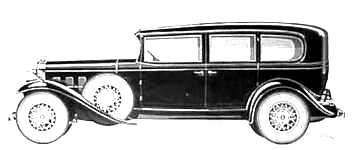
(Left) sedan for 5 passengers [short body],
(right) limousine for 7 passengers
V16 ID: basically unchanged from 1930.
Models: [this summary list is from Automobile Topics,
January 3, 1931; there were many more]: Fisher "Custom" on 134" wheel base
V8 chassis: (1) 2-passenger Coupe ($2695), 4480lbs; (2) 5-passenger Coupe
($2795), 4500lbs; (3) 5-passenger Sedan ($2795), 4660lbs; (4) 5-passenger
Town Sedan ($2845), 4675lbs; (6). 2-passenger Roadster ($2845), 4355lbs; (7)
2-passenger Convertible Coupe ($2945), 4450lbs; (8) 7-passenger Sedan
($2945), 4780lbs; (9) 5-passenger Phaeton ($2945), 4395lbs (photo CCI,
27:1); (10) 7-passenger Imperial Sedan ($3095), 4835lbs: (11) 5-passenger
All-Weather Phaeton ($3795), 4685lbs. V12 bodies on 140" wheel base: (12)
2-passenger Coupe ($3795); (13) 5-passenger Coupe ($3895); (14) 5-passenger
Sedan ($3895); (15) 5-passenger Town Sedan ($3945) [photo in TQ, 5-6/83,
p.23]; (16) 2-passenger Roadster ($3945); (17) 2-passenger Convertible Coupe
($4045); (18) 5-passenger Phaeton ($4045) [photo: CCI, 30:7]; (19)
7-passenger Sedan ($4195); (20) 7-passenger Imperial Sedan ($4345); (21)
5-passenger All-Weather Phaeton ($4895). (22) Special V12 boat-tail (CCI,
27:2). Standard V16 Fleetwood styles: (23) 2-passenger Roadster ($5350), 5325lbs; (24)
5-passenger All-Weather Phaeton ($5750), 5690lbs; (25) 2-passenger Coupe ($5800),
5765lbs; (26) 5-passenger Club Sedan ($5950), 5740lbs; (27) 7-passenger
Sedan ($6225); (28) 5-passenger Imperial Sedan ($6300), 5920lbs; (29)
5-passenger Imperial Sedan ($6300), 5920bs; (30) 5-passenger Phaeton ($6500),
5690lbs; (31) 7-passenger Imperial Sedan ($6525), 6020lbs; (32) 2-passenger
Convertible Coupe ($6900), 5670lbs; (33) 7-passenger Town Brougham ($9200), 6020lbs
(V16 style 4380 phaeton, 4130 Sedan, 4260 sport phaeton, 4260 d/c phaeton, 4302 roadster,
Pinin Farina boat-tail speedster all illustrated in C&D card set). A revised
price list was published in Automobile Topics, October 3, 1931; prices and models were
basically unchanged from January 1931: added were (34) a V12 5-passenger Coupe
($3895); (35) a 7-passenger Sedan ($4195); (36) a 7-passenger Imperial.
Engine numbers, Series 355, V-8:
800001 to 810717 [1930-1931]
Engine numbers, Series 370, V-12:
1000001 to
1005733 [1930-1931]
Engine numbers, Series 452-452A, V-16:
700001 to 703251 [1930-1931]
Trivia: In the British
monthly The Motor, for 24.3.31, there was an ad for this unique V16 Cadillac with
latest-type sports saloon by Carrosserie Vanden Plas, in French grey, luxuriously
finished, fitted sunshine roof and numerous extras, £2350. This is the car
illustrated on page 70 [top LH side] of Roy Schneider's book Sixteen Cylinder Motor
cars. I wonder what happened to it?
_____________________
1 Photo and description: RBC,
p.66
2 Photo and
full description in GH book, p.81
|